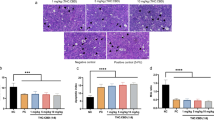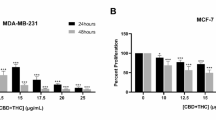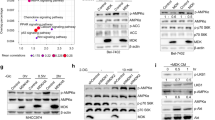Abstract
Identifying the molecular mechanisms responsible for the resistance of gliomas to anticancer treatments is an issue of great therapeutic interest. Δ9-Tetrahydrocannabinol (THC), the major active ingredient of marijuana, and other cannabinoids inhibit tumor growth in animal models of cancer, including glioma, an effect that relies, at least in part, on the stimulation of autophagy-mediated apoptosis in tumor cells. Here, by analyzing the gene expression profile of a large series of human glioma cells with different sensitivity to cannabinoid action, we have identified a subset of genes specifically associated to THC resistance. One of these genes, namely that encoding the growth factor midkine (Mdk), is directly involved in the resistance of glioma cells to cannabinoid treatment. We also show that Mdk mediates its protective effect via the anaplastic lymphoma kinase (ALK) receptor and that Mdk signaling through ALK interferes with cannabinoid-induced autophagic cell death. Furthermore, in vivo Mdk silencing or ALK pharmacological inhibition sensitizes cannabinod-resistant tumors to THC antitumoral action. Altogether, our findings identify Mdk as a pivotal factor involved in the resistance of glioma cells to THC pro-autophagic and antitumoral action, and suggest that selective targeting of the Mdk/ALK axis could help to improve the efficacy of antitumoral therapies for gliomas.
Similar content being viewed by others
Log in or create a free account to read this content
Gain free access to this article, as well as selected content from this journal and more on nature.com
or
Abbreviations
- THC:
-
Δ9-tetrahydrocannabinol
- GBM:
-
glioblastoma multiforme
- ER:
-
endoplasmic reticulum
- TRB3:
-
tribbles homolog 3
- mTORC1:
-
mammalian target of rapamycin complex 1m
- ALK:
-
anaplastic lymphoma kinase receptor
- Mdk:
-
midkine
- PTN:
-
pleiotrophin
- PI3K:
-
phosphatidylinositol 3-kinase
- RPTP:
-
protein-tyrosine phosphatase, receptor-type, zeta-1
- LRP1:
-
low-density lipoprotein receptor-related protein 1
References
Nieder C, Adam M, Molls M, Grosu AL . Therapeutic options for recurrent high-grade glioma in adult patients: recent advances. Crit Rev Oncol Hematol 2006; 60: 181–193.
Louis DN, Ohgaki H, Wiestler OD, Cavenee WK, Burger PC, Jouvet A et al. The 2007 WHO classification of tumours of the central nervous system. Acta Neuropathol 2007; 114: 97–109.
Verhaak RG, Hoadley KA, Purdom E, Wang V, Qi Y, Wilkerson MD et al. Integrated genomic analysis identifies clinically relevant subtypes of glioblastoma characterized by abnormalities in PDGFRA, IDH1, EGFR, and NF1. Cancer Cell 2010; 17: 98–110.
Purow B, Schiff D . Advances in the genetics of glioblastoma: are we reaching critical mass? Nat Rev Neurol 2009; 5: 419–426.
Huse JT, Holland EC . Targeting brain cancer: advances in the molecular pathology of malignant glioma and medulloblastoma. Nat Rev Cancer 2010; 10: 319–331.
Howlett AC, Barth F, Bonner TI, Cabral G, Casellas P, Devane WA et al. International Union of Pharmacology. XXVII. Classification of cannabinoid receptors. Pharmacol Rev 2002; 54: 161–202.
Fernandez-Ruiz J, Romero J, Velasco G, Tolon RM, Ramos JA, Guzman M . Cannabinoid CB2 receptor: a new target for controlling neural cell survival? Trends Pharmacol Sci 2007; 28: 39–45.
Guzman M . Cannabinoids: potential anticancer agents. Nat Rev Cancer 2003; 3: 745–755.
Carracedo A, Lorente M, Egia A, Blazquez C, Garcia S, Giroux V et al. The stress-regulated protein p8 mediates cannabinoid-induced apoptosis of tumor cells. Cancer Cell 2006; 9: 301–312.
Galve-Roperh I, Sanchez C, Cortes ML, Gomez del Pulgar T, Izquierdo M, Guzman M . Anti-tumoral action of cannabinoids: involvement of sustained ceramide accumulation and extracellular signal-regulated kinase activation. Nat Med 2000; 6: 313–319.
Velasco G, Carracedo A, Blazquez C, Lorente M, Aguado T, Haro A et al. Cannabinoids and gliomas. Mol Neurobiol 2007; 36: 60–67.
Guzman M, Duarte MJ, Blazquez C, Ravina J, Rosa MC, Galve-Roperh I et al. A pilot clinical study of Delta9-tetrahydrocannabinol in patients with recurrent glioblastoma multiforme. Br J Cancer 2006; 95: 197–203.
Sarfaraz S, Adhami VM, Syed DN, Afaq F, Mukhtar H . Cannabinoids for cancer treatment: progress and promise. Cancer Res 2008; 68: 339–342.
Carracedo A, Gironella M, Lorente M, Garcia S, Guzman M, Velasco G et al. Cannabinoids induce apoptosis of pancreatic tumor cells via endoplasmic reticulum stress-related genes. Cancer Res 2006; 66: 6748–6755.
Salazar M, Carracedo A, Salanueva IJ, Hernandez-Tiedra S, Lorente M, Egia A et al. Cannabinoid action induces autophagy-mediated cell death through stimulation of ER stress in human glioma cells. J Clin Invest 2009; 119: 1359–1372.
Kadomatsu K . The midkine family in cancer, inflammation and neural development. Nagoya J Med Sci 2005; 67: 71–82.
Kadomatsu K, Tomomura M, Muramatsu T . cDNA cloning and sequencing of a new gene intensely expressed in early differentiation stages of embryonal carcinoma cells and in mid-gestation period of mouse embryogenesis. Biochem Biophys Res Commun 1988; 151: 1312–1318.
Chen S, Bu G, Takei Y, Sakamoto K, Ikematsu S, Muramatsu T et al. Midkine and LDL-receptor-related protein 1 contribute to the anchorage-independent cell growth of cancer cells. J Cell Sci 2007; 120: 4009–4015.
Mirkin BL, Clark S, Zheng X, Chu F, White BD, Greene M et al. Identification of midkine as a mediator for intercellular transfer of drug resistance. Oncogene 2005; 24: 4965–4974.
Stoica GE, Kuo A, Powers C, Bowden ET, Sale EB, Riegel AT et al. Midkine binds to anaplastic lymphoma kinase (ALK) and acts as a growth factor for different cell types. J Biol Chem 2002; 277: 35990–35998.
Rubinsztein DC, Gestwicki JE, Murphy LO, Klionsky DJ . Potential therapeutic applications of autophagy. Nat Rev Drug Discov 2007; 6: 304–312.
Herrera B, Carracedo A, Diez-Zaera M, Gomez del Pulgar T, Guzman M, Velasco G . The CB2 cannabinoid receptor signals apoptosis via ceramide-dependent activation of the mitochondrial intrinsic pathway. Exp Cell Res 2006; 312: 2121–2131.
Caffarel MM, Sarrio D, Palacios J, Guzman M, Sanchez C . Delta9-tetrahydrocannabinol inhibits cell cycle progression in human breast cancer cells through Cdc2 regulation. Cancer Res 2006; 66: 6615–6621.
Tong Y, Mentlein R, Buhl R, Hugo HH, Krause J, Mehdorn HM et al. Overexpression of midkine contributes to anti-apoptotic effects in human meningiomas. J Neurochem 2007; 100: 1097–1107.
Kuo AH, Stoica GE, Riegel AT, Wellstein A . Recruitment of insulin receptor substrate-1 and activation of NF-kappaB essential for midkine growth signaling through anaplastic lymphoma kinase. Oncogene 2007; 26: 859–869.
Moog-Lutz C, Degoutin J, Gouzi JY, Frobert Y, Brunet-de Carvalho N, Bureau J et al. Activation and inhibition of anaplastic lymphoma kinase receptor tyrosine kinase by monoclonal antibodies and absence of agonist activity of pleiotrophin. J Biol Chem 2005; 280: 26039–26048.
Mourali J, Benard A, Lourenco FC, Monnet C, Greenland C, Moog-Lutz C et al. Anaplastic lymphoma kinase is a dependence receptor whose proapoptotic functions are activated by caspase cleavage. Mol Cell Biol 2006; 26: 6209–6222.
Palmer RH, Vernersson E, Grabbe C, Hallberg B . Anaplastic lymphoma kinase: signalling in development and disease. Biochem J 2009; 420: 345–361.
Chen Y, Takita J, Choi YL, Kato M, Ohira M, Sanada M et al. Oncogenic mutations of ALK kinase in neuroblastoma. Nature 2008; 455: 971–974.
Mosse YP, Laudenslager M, Longo L, Cole KA, Wood A, Attiyeh EF et al. Identification of ALK as a major familial neuroblastoma predisposition gene. Nature 2008; 455: 930–935.
George RE, Sanda T, Hanna M, Frohling S, Luther II W, Zhang J et al. Activating mutations in ALK provide a therapeutic target in neuroblastoma. Nature 2008; 455: 975–978.
Janoueix-Lerosey I, Lequin D, Brugieres L, Ribeiro A, de Pontual L, Combaret V et al. Somatic and germline activating mutations of the ALK kinase receptor in neuroblastoma. Nature 2008; 455: 967–970.
Allouche M . ALK is a novel dependence receptor: potential implications in development and cancer. Cell Cycle 2007; 6: 1533–1538.
Powers C, Aigner A, Stoica GE, McDonnell K, Wellstein A . Pleiotrophin signaling through anaplastic lymphoma kinase is rate-limiting for glioblastoma growth. The J Biol Chem 2002; 277: 14153–14158.
Ivy SP, Wick JY, Kaufman BM . An overview of small-molecule inhibitors of VEGFR signaling. Nat Rev Clin Oncol 2009; 6: 569–579.
de Bono JS, Ashworth A . Translating cancer research into targeted therapeutics. Nature 2010; 467: 543–549.
Dempke WC, Heinemann V . Resistance to EGF-R (erbB-1) and VEGF-R modulating agents. Eur J Cancer 2009; 45: 1117–1128.
Lorente M, Carracedo A, Torres S, Natali F, Egia A, Hernandez-Tiedra S et al. Amphiregulin is a factor for resistance of glioma cells to cannabinoid-induced apoptosis. Glia 2009; 57: 1374–1385.
Takei Y, Kadomatsu K, Goto T, Muramatsu T . Combinational antitumor effect of siRNA against midkine and paclitaxel on growth of human prostate cancer xenografts. Cancer 2006; 107: 864–873.
Palacios J, Honrado E, Osorio A, Cazorla A, Sarrio D, Barroso A et al. Immunohistochemical characteristics defined by tissue microarray of hereditary breast cancer not attributable to BRCA1 or BRCA2 mutations: differences from breast carcinomas arising in BRCA1 and BRCA2 mutation carriers. Clin Cancer Res 2003; 9: 3606–3614.
Acknowledgements
This work was supported by grants from Spanish Ministry of Science and Innovation (MICINN) (PS09/01401; HF2005/0021, FR2009-0052 and IT2009-0053 to GV; SAF2006/00918 to MG), Santander-Complutense (PR34/07-15856 to GV), Comunidad de Madrid (S-SAL/0261/2006 to MG). ML was sequentially the recipient of a ‘Juan de la Cierva’ contract, a postdoctoral contract from Spanish Ministry of Education and Science (MEC) and a postdoctoral contract from Comunidad de Madrid. ST was recipient of a research formation contract from Comunidad de Madrid, MS was recipient of a fellowship from MEC and of a research formation contract from Comunidad de Madrid, AC was recipient of fellowships from Gobierno Vasco, FEBS and EMBO. SH-T has a technician contract from MICINN and Fondo Social Europeo. We thank Horacio Zimman and Carmen Moreno from Hospital Clínico San Carlos as well as Leyre Urigüen from Universidad del Pais Vasco for their kind collaboration in the processing and delivery of glioma samples; Miguel Ángel Piris, Raquel Villuendas, Paloma Cueva and Rosa Pérez for technical advice in the gene expression experiments and other members of our lab for their continuous support.
Author information
Authors and Affiliations
Corresponding author
Ethics declarations
Competing interests
The authors declare no conflict of interest.
Additional information
Edited by P Mehlen
Supplementary Information accompanies the paper on Cell Death and Differentiation website
Supplementary information
Rights and permissions
About this article
Cite this article
Lorente, M., Torres, S., Salazar, M. et al. Stimulation of the midkine/ALK axis renders glioma cells resistant to cannabinoid antitumoral action. Cell Death Differ 18, 959–973 (2011). https://doi.org/10.1038/cdd.2010.170
Received:
Revised:
Accepted:
Published:
Issue date:
DOI: https://doi.org/10.1038/cdd.2010.170
Keywords
This article is cited by
-
Midkine noncanonically suppresses AMPK activation through disrupting the LKB1-STRAD-Mo25 complex
Cell Death & Disease (2022)
-
CAF-derived midkine promotes EMT and cisplatin resistance by upregulating lncRNA ST7-AS1 in gastric cancer
Molecular and Cellular Biochemistry (2022)
-
Serum midkine as non-invasive biomarker for detection and prognosis of non-small cell lung cancer
Scientific Reports (2021)
-
Cannabinoids in the landscape of cancer
Journal of Cancer Research and Clinical Oncology (2021)
-
Midkine (MDK) growth factor: a key player in cancer progression and a promising therapeutic target
Oncogene (2020)



